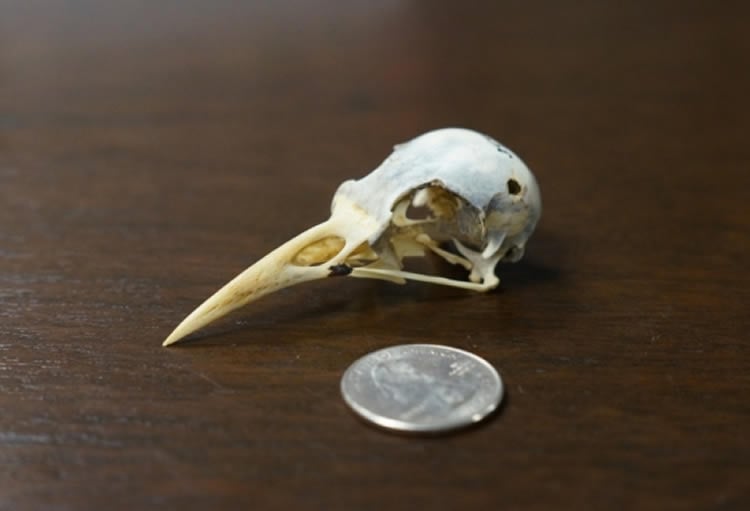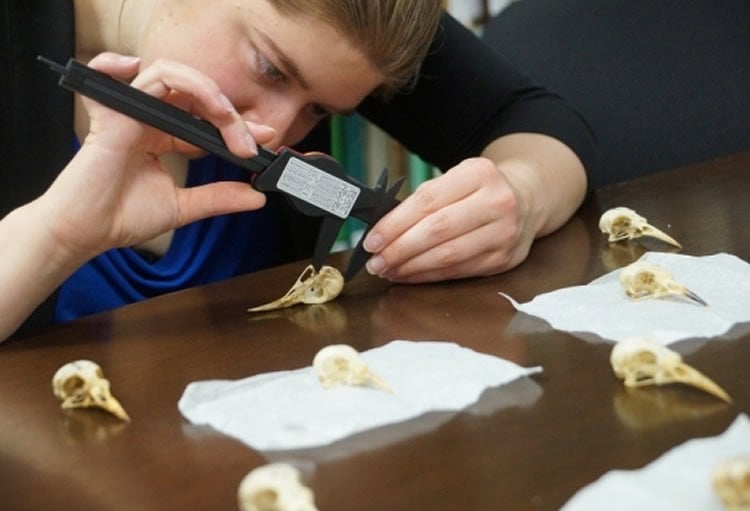Researchers find the method commonly used to compare the size of an animal’s skull — and its brain — across species can be far from accurate.
In research, sometimes setting out to demonstrate one concept actually results in proving something entirely different. It’s important to be flexible.
Take, for example, Corina Logan, whose work focuses on the cognitive abilities of the great-tailed grackle, a member of the blackbird family. A junior research fellow at UC Santa Barbara’s SAGE Center for the Study of the Mind when she conducted her research, Logan sought to find a way to accurately approximate the brain size of live grackles by measuring their heads rather than the inside of their skulls.
Instead, she discovered that the method biologists and other scientists have been using to compare brain size across species is not appropriate for looking at individual differences within a species — particularly this species. Her findings, supported by the National Geographic Society/Waitt Grants Program, are published in the scholarly journal PeerJ.
“People love to study brain size,” said Logan, currently a Leverhulme Early Career Research Fellow in the Department of Zoology at the University of Cambridge. “It’s a huge topic. And there is growing interest in how brain size varies within a species, which can tell us what factors contribute to the evolution of large brains.”
To understand what’s going on within a species, Logan continued, you have to know how to measure their brains. And if you want to study wild species without killing your subjects, you have to figure out a way to measure their brains without removing them from their respective skulls.
“That’s what I was trying to do — study them in the wild after measuring them so I could see whether their brain size influences their behavior or the number of offspring they have,” she explained. “I was trying to measure brain size without measuring their actual brains.”
So Logan and co-author Christin Palmstrom, an undergraduate student in biology when the research was conducted, acquired skulls from museums and measured them via two methods: They used CT scans to measure the volume of the inside of the braincase and they used calipers to measure the external skull. The scanned the skulls and then used computer software to calculate the endocranial volume, which, according to Logan, is a common proxy for brain size. The CT scan was the more accurate method for calculating endocranial volume, to which they compared length, width and height measurements the made using the calipers.
“If the external skull measurements matched the volumes from the CT scans well enough, then we could use the CT scan or caliper methods interchangeably,” Logan said.
They don’t.
According to Logan, it’s impossible to approximate brain size using the external skull measurement because it varies so much within this species. That was surprising to her on a couple of levels. “First, I was surprised that the external skull measurements did not accurately predict the actual endocranial volumes,” she said. “But I was also surprised that there was so much variation, particularly in males.”
Scientists don’t generally publish negative results — i.e. not finding what they’re looking for — but in this case, Logan’s unexpected result is quite interesting. She demonstrated that the Pearson product-moment correlation coefficient, which is commonly used to measure the degree to which two variables relate to each other (such as the two indirect measures of brain size), is not the right test to apply to these data. It overlooks differences in the individual data points, she noted, which was the whole point of the study.

“People see a ‘significant correlation’ between two sets of measurements and think it works,” Logan said. “But it’s often not a very tight correlation. There is an overreliance on any level of correlation as long as it’s significant.”
So Logan decided to try a different analysis to confirm — or not — how well the external skull measurements approximate endocranial volume calculations. Her question: If you gather data from new skulls, how well will these external skull measurements predict endocranial volume using the CT scan method if you don’t actually CT scan the skulls?
“What I found is that if you plug in a new number, you can’t tell it apart from the other numbers in the data set because the prediction intervals for most of the data points overlapped with each other,” she said. “So the external skull measurements aren’t helpful. They don’t tell us what their brain size actually is.” The results, she added, emphasize the importance of validating and explicitly quantifying the predictive accuracy of brain size proxies for each species and sex.
According to Logan, scientists can no longer take for granted what has previously been determined as accurate and correct. “Statistical methods in biology are in flux right now,” she said. “People are switching from using statistics based on p-values, like the Pearson correlation, to methods that allow one to look at the finer details of the effects occurring in the data set.”
Key to the success of this research, according to Logan was UCSB’s Cheadle Center for Biodiversity and Ecological Restoration (CCBER), which preserves and manages multiple natural history collections, including plants, animals, algae and diatoms. This “amazing resource,” as she described it, enabled Palmstrom, to gather the necessary data for the research project. And for that she needed a large enough number of intact grackle skulls for this species, which aren’t available in California.

“Christin was doing some volunteer work at CCBER and found out they could borrow the specimens from other museums,” said Logan. In this case, CCBER borrowed grackle skulls from the Museum of Southwestern Biology in Albuquerque, New Mexico, and the University of Kansas Biodiversity Institute to complete the sample size, which also included one skull from the Santa Barbara Museum of Natural History.
“So Christin would wait for the skulls to arrive and then go to CCBER to measure them,” Logan went on. “Collections manager Mireia Beas-Moix handled everything and helped us find more skulls. Usually research dollars are tight and no one has the resources to offer assistance like this, but CCBER was a wealth of support.”
In her work, Logan studies live birds rather than skeletons, but as she said, “Working with museum specimens can fill a really important piece of the puzzle for me.
Source: Andrea Estrada – UC Santa Barbara
Image Credit: Images credited to Sonia Fernandez
Original Research: Full open access research for “Can endocranial volume be estimated accurately from external skull measurements in great-tailed grackles (Quiscalus mexicanus)?” by Corina J. Logan and Christin R. Palmstrom in PeerJ. Published online June 11 2015 doi:10.7717/peerj.1000
Abstract
Can endocranial volume be estimated accurately from external skull measurements in great-tailed grackles (Quiscalus mexicanus)?
There is an increasing need to validate and collect data approximating brain size on individuals in the field to understand what evolutionary factors drive brain size variation within and across species. We investigated whether we could accurately estimate endocranial volume (a proxy for brain size), as measured by computerized tomography (CT) scans, using external skull measurements and/or by filling skulls with beads and pouring them out into a graduated cylinder for male and female great-tailed grackles. We found that while females had higher correlations than males, estimations of endocranial volume from external skull measurements or beads did not tightly correlate with CT volumes. We found no accuracy in the ability of external skull measures to predict CT volumes because the prediction intervals for most data points overlapped extensively. We conclude that we are unable to detect individual differences in endocranial volume using external skull measurements. These results emphasize the importance of validating and explicitly quantifying the predictive accuracy of brain size proxies for each species and each sex.
“Can endocranial volume be estimated accurately from external skull measurements in great-tailed grackles (Quiscalus mexicanus)?” by Corina J. Logan and Christin R. Palmstrom in PeerJ. Published online June 11 2015 doi:10.7717/peerj.1000






